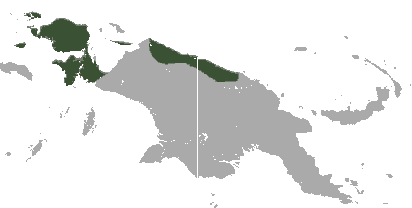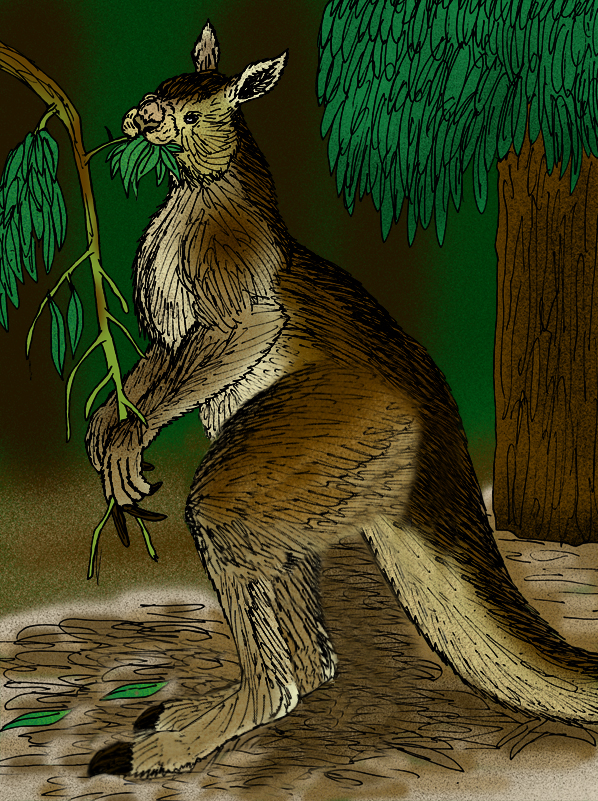|
Dingiso
The dingiso () (''Dendrolagus mbaiso''), also known as the bondegezou or bakaga, is an endangered, long-tailed marsupial found only in mountain forests on the west of the island of New Guinea (in Indonesia). It is a species of tree-kangaroo (genus '' Dendrolagus''), which are mammals native to Australia and New Guinea that feed on leaves or other plant matter. It belongs to the macropodid family (Macropodidae) with kangaroos, and carries its young in a pouch like most other marsupials. Though sacred to the local Moni people, it is still threatened by hunting and habitat loss. Dr Tim Flannery and his team gave the species name ''mbaiso'' which means "the forbidden animal" in Moni, because of the local belief that dingiso is the spirit of their ancestors. Locally Dingiso is called ''Bakaga''. Distribution The marsupial lives in sub-alpine forests in the Sudirman Range in Central Papua and Highland Papua in Western New Guinea. It lives just below the tree line, at elevations of ... [...More Info...] [...Related Items...] OR: [Wikipedia] [Google] [Baidu] |
Dendrolagus
Tree-kangaroos are marsupials of the genus ''Dendrolagus'', adapted for arboreal locomotion. They inhabit the tropical rainforests of New Guinea and far northeastern Queensland, Australia along with some of the islands in the region. All tree-kangaroos are considered threatened due to hunting and habitat destruction. They are the only true arboreal macropods. Evolutionary history The evolutionary history of tree-kangaroos possibly begins with a rainforest floor-dwelling pademelon-like ancestor. This ancestor possibly evolved from an arboreal possum-like ancestor as is suspected of all macropodid marsupials in Australia and New Guinea. During the late Eocene, the Australian/New Guinean continent began a period of drying that caused a retreat in the area of rainforest, which forced the ancestral pademelons to begin living in a drier, rockier environment. After some generations of adaptation to the new environment, the pademelons may have evolved into rock-wallabies (''Petroga ... [...More Info...] [...Related Items...] OR: [Wikipedia] [Google] [Baidu] |
Tim Flannery
Timothy Fridtjof Flannery (born 28 January 1956) is an Australian mammalogist, palaeontologist, environmentalist, conservationist, explorer, author, science communicator Science communication encompasses a wide range of activities that connect science and society. Common goals of science communication include informing non-experts about scientific findings, raising the public awareness of and interest in sci ..., activist, and public scientist. He is especially known for his 1994 book ''The Future Eaters'', on the natural history of Australasia, which was adapted for television in 2006, and his 2006 book ''The Weather Makers'', about the effects of climate change in Australia. As a researcher, Flannery had roles at several universities and museums in Australia, specialising in fossil marsupials and Evolution of mammals, mammal evolution. He made notable contributions to the palaeontology of Australia and New Guinea during the 1980s, including reviewing the evolution a ... [...More Info...] [...Related Items...] OR: [Wikipedia] [Google] [Baidu] |
Macropodidae
Macropodidae is a Family (biology), family of marsupials that includes kangaroos, Wallaby, wallabies, tree-kangaroos, wallaroos, pademelons, quokkas, and several other groups. These genera are allied to the suborder Macropodiformes, containing other macropods, and are native to the Australia (continent), Australian continent (the mainland and Tasmania), New Guinea and nearby islands. Description Although Propleopus, omnivorous kangaroos lived in the past, these were not members of the family Macropodidae; modern macropods are generally Herbivore, herbivorous. Some are Browsing (herbivory), browsers, but most are Grazing, grazers and are equipped with appropriately specialised teeth for cropping and grinding up fibrous plants, in particular grasses and Cyperaceae, sedges. Modern omnivorous kangaroos generally belong to a different family (for example, the Musky rat-kangaroo). In general, macropods have a broad, straight row of cutting teeth at the front of the mouth, no Canine t ... [...More Info...] [...Related Items...] OR: [Wikipedia] [Google] [Baidu] |
Moni People
The Moni (also known as the Migani, the Megani, the Djonggunu, or the Jonggunu) are an indigenous people in the Indonesian Paniai regency (kabupaten) of Central Papua in Western New Guinea. They speak the Moni language. The Moni revere the bondegezou, a large black and white whistling tree kangaroo, as an ancestor. The bondegezou was unknown to the scientific community until the zoologist Tim Flannery described it in 1995. See also *Indigenous people of New Guinea The indigenous peoples of Western New Guinea in Indonesia and Papua New Guinea, commonly called Papuans, are Melanesians. There is genetic evidence for two major historical lineages in New Guinea and neighboring islands: a first wave from the Mal ... References Ethnic groups in Indonesia Indigenous ethnic groups in Western New Guinea {{asia-ethno-group-stub ... [...More Info...] [...Related Items...] OR: [Wikipedia] [Google] [Baidu] |
Australian Museum
The Australian Museum, originally known as the Colonial Museum or Sydney Museum. is a heritage-listed museum at 1 William Street, Sydney, William Street, Sydney central business district, Sydney CBD, New South Wales. It is the oldest natural history museum in Australia and the fifth oldest natural history museum in the world, with an international reputation in the fields of natural history and anthropology. It was first conceived and developed along the contemporary European model of an encyclopedic warehouse of cultural and natural history, and features collections of vertebrate and invertebrate zoology, as well as mineralogy, palaeontology and anthropology. The scientific stature of the museum was established under the curatorship of scientist Gerard Krefft in the 1860s. Apart from permanent displays in its galleries, permanent and temporary exhibitions, the museum also undertakes research and is involved in community programs. Since 1973 it has operated the Lizard Island ... [...More Info...] [...Related Items...] OR: [Wikipedia] [Google] [Baidu] |
Endangered Fauna Of Oceania
An endangered species is a species that is very likely to become extinct in the near future, either worldwide or in a particular political jurisdiction. Endangered species may be at risk due to factors such as habitat loss, poaching, invasive species, and climate change. The International Union for Conservation of Nature (IUCN) Red List lists the global conservation status of many species, and various other agencies assess the status of species within particular areas. Many nations have laws that protect conservation-reliant species which, for example, forbid hunting, restrict land development, or create protected areas. Some endangered species are the target of extensive conservation efforts such as captive breeding and habitat restoration. Human activity is a significant cause in causing some species to become endangered. Conservation status The conservation status of a species indicates the likelihood that it will become extinct. Multiple factors are considered when ... [...More Info...] [...Related Items...] OR: [Wikipedia] [Google] [Baidu] |
Mammals Of Western New Guinea
A mammal () is a vertebrate animal of the class Mammalia (). Mammals are characterised by the presence of milk-producing mammary glands for feeding their young, a broad neocortex region of the brain, fur or hair, and three middle ear bones. These characteristics distinguish them from reptiles and birds, from which their ancestors diverged in the Carboniferous Period over 300 million years ago. Around 6,640 extant species of mammals have been described and divided into 27 orders. The study of mammals is called mammalogy. The largest orders of mammals, by number of species, are the rodents, bats, and eulipotyphlans (including hedgehogs, moles and shrews). The next three are the primates (including humans, monkeys and lemurs), the even-toed ungulates (including pigs, camels, and whales), and the Carnivora (including cats, dogs, and seals). Mammals are the only living members of Synapsida; this clade, together with Sauropsida (reptiles and birds), constitutes the lar ... [...More Info...] [...Related Items...] OR: [Wikipedia] [Google] [Baidu] |
Endemic Fauna Of Indonesia
Endemism is the state of a species being found only in a single defined geographic location, such as an island, state, nation, country or other defined zone; organisms that are indigenous to a place are not endemic to it if they are also found elsewhere. For example, the Cape sugarbird is found exclusively in southwestern South Africa and is therefore said to be ''endemic'' to that particular part of the world. An endemic species can also be referred to as an ''endemism'' or, in scientific literature, as an ''endemite''. Similarly, many species found in the Western ghats of India are examples of endemism. Endemism is an important concept in conservation biology for measuring biodiversity in a particular place and evaluating the risk of extinction for species. Endemism is also of interest in evolutionary biology, because it provides clues about how changes in the environment cause species to undergo range shifts (potentially expanding their range into a larger area or becomin ... [...More Info...] [...Related Items...] OR: [Wikipedia] [Google] [Baidu] |
Marsupials Of New Guinea
Marsupials are a diverse group of mammals belonging to the infraclass Marsupialia. They are natively found in Australasia, Wallacea, and the Americas. One of marsupials' unique features is their reproductive strategy: the young are born in a relatively undeveloped state and then nurtured within a pouch on their mother's abdomen. Extant marsupials encompass many species, including kangaroos, koalas, opossums, possums, Tasmanian devils, wombats, wallabies, and bandicoots. Marsupials constitute a clade stemming from the last common ancestor of extant Metatheria, which encompasses all mammals more closely related to marsupials than to placentals. The evolutionary split between placentals and marsupials occurred 125-160 million years ago, in the Middle Jurassic-Early Cretaceous period. Presently, close to 70% of the 334 extant marsupial species are concentrated on the Australian continent, including mainland Australia, Tasmania, New Guinea, and nearby islands. The remainin ... [...More Info...] [...Related Items...] OR: [Wikipedia] [Google] [Baidu] |
Macropods
Macropod may refer to: * Macropodidae, a marsupial family which includes kangaroos, wallabies, tree-kangaroos, pademelons, and several others * Macropodiformes The Macropodiformes , also known as macropods, are one of the three suborders of the large marsupial order Diprotodontia. They may in fact be nested within one of the suborders, Phalangeriformes. Kangaroos, wallabies and allies, bettongs, p ..., a marsupial suborder which includes kangaroos, wallabies and allies, bettongs, potoroos, and rat kangaroos See also * '' Macropodia'', genus of crabs * Megapode, chicken-like birds in the family ''Megapodiidae'' {{disambiguation Animal common name disambiguation pages ... [...More Info...] [...Related Items...] OR: [Wikipedia] [Google] [Baidu] |
Endangered Species
An endangered species is a species that is very likely to become extinct in the near future, either worldwide or in a particular political jurisdiction. Endangered species may be at risk due to factors such as habitat loss, poaching, invasive species, and climate change. The International Union for Conservation of Nature (IUCN) Red List lists the global conservation status of many species, and various other agencies assess the status of species within particular areas. Many nations have laws that protect conservation-reliant species which, for example, forbid hunting, restrict land development, or create protected areas. Some endangered species are the target of extensive conservation efforts such as captive breeding and habitat restoration. Human activity is a significant cause in causing some species to become endangered. Conservation status The conservation status of a species indicates the likelihood that it will become extinct. Multiple factors are ... [...More Info...] [...Related Items...] OR: [Wikipedia] [Google] [Baidu] |







